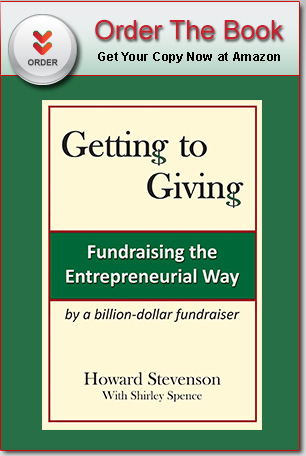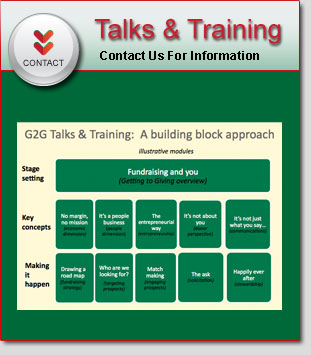Crowdfunding basically involves collecting money from backers – the “crowd” – for a for- profit or nonprofit initiative, usually on an Internet platform.
There’s no denying that crowdfunding is hot. If it’s new to you, a Forbes article entitled “Top 10 Crowdfunding Sites for Fundraising” may be of interest as a quick intro. There are a variety of flavor of crowdfunding out there, and a lot of hype.
In the nonprofit world, crowdfunding is more useful for a participative fundraising strategy (i.e., getting a lot of people to give a little something) than significant gift fundraising, I believe. I also must state the obvious: It ain’t free. As with any approach, you have to weigh the costs and the benefits.
There’s nothing like first-hand experience, though. I readily admit that I have none when it comes to crowdfunding, so I have asked my friend Jeff Cruikshank to share what he has learned from his recent foray into nonprofit crowdfunding.
Here it is, with our thanks to Jeff!
Crowdfunding is a hot topic among the development community. Especially as annual giving rates continue to decline nationwide — and as donors increasingly want to see an impact growing directly out of their dollars — people are intrigued by/scared by crowd funding.
It’s exacerbated by the parade of individual success stories that you see in the papers — for example, the BU student who recently raised $5,000 in 27 hours to help pay her tuition bill. (http://www.bostonglobe.com/metro/2013/11/13/crowdfunding-pays-off-for-student/OCbSkZLlEkQBORcR29qx6J/story.html)
Never mind that you never hear about the failures. “Crowdfunding” appears to translate into “instant and universal success.”
Not true! Unless your story goes viral — which is what everybody wants and almost nobody gets — you have to find other ways of succeeding at crowd funding.
First of all: why would an overtaxed development staff want to get into it? Several reasons:
•Institutional control. As in the case above, if you let an individual define your institution, you’re taking a reputational risk. The other side of the coin: If you can put up an impressive array of projects (and assuming anybody visits your site), you can make your institution look just as interesting and dynamic as it is.
•Donor acquisition. US News & World Report rankings are driven in part by alumni participation rates. This is one of the few rankings criteria that institutions can tackle head on and influence. If crowd funding brings in whole new populations of donors — even at relatively low dollar rates — that can create great advantage for the university.
•Dollar acquisition. Lest we forget: fund raising raises funds, although not huge dollars. But high-visibility, high-impact projects, both on the faculty and student sides of the shop, don’t always need big dollars.
•Good impact stories. Institutions always need compelling tales about small-dollar impact. Crowdfunding is a natural for this.
•Wild cards. It’s possible that the big prospect who won’t take a call from your major gifts team will respond to an appropriate crowd funding opportunity. Several California schools have reported that this happens more often than it doesn’t . . . with very positive results . . .
So how do you do it?
•Assemble the constituents. Make a task force on which both faculty and student interests are represented. Get development, and especially the “back office” end of development — gifts & records, stewardship, etc. — involved.
•Lower expectations. If anyone in your hierarchy thinks crowd funding will lead to easy or instant success, disabuse them of that idea. It won’t.
•Survey the landscape. Which existing platforms do you like, and why?
•Find a platform. It ain’t necessarily Kickstarter or IndieGogo. They take between 3 and 9 percent off the top, and, you don’t get to control the data. Scalefunder (recently purchased by RuffaloCody) is currently a platform of choice. Look for a vendor who will hold your hand, as well as rent you software.
•Prototype. As the great Howard Stevenson points out, entrepreneurs don’t go looking for risks; they seek to minimize, mitigate, and lay off risks. Think about a couple of projects coming together many months down the road. Don’t put out a call for entries. The first phase isn’t democratic.
•Pick your initial projects very carefully. A most important point: Crowdfunding only works if you can assemble a crowd. Period! Full stop! The BU student assembled a crowd by going viral. Most likely, your project leaders won’t; they will have to run what amounts to a mini-campaign. Think Girl Scout cookies, door to door. How many people do you know — yes, starting with your mother — who will buy cookies from you?
•Set realistic goals. Better to overshoot than undershoot your target. Think four-figures, or low five-figures, unless you can ID big dollars in advance.
•Think homespun. You don’t want to look fancy. Yes, video. No, not big production values. You can use your iPhone, but invest in an external mike for sound quality.
•Think “mini-campaign.” Yes, indeed. You need an opening event. (A barbecue at your house?) You need a quiet phase and a nucleus fund. You need a front man and worker bees.
•Don’t be overly seduced by social media. Guess what? Facebook, Twitter, Instagram, etc., etc., aren’t particularly useful for assembling the crowd you need. Guess what works? Personalized emails. (Gasp! How old-fashioned!) But it’s true.
•Steward, steward, steward. Give ‘em a tax receipt instantly. (How’s that back end working?) Send ‘em a personal email almost instantly. Through your excellent platform, send regular updates. Go back to video for periodic site-based updates.
•Look, listen, and learn. Use your beta phase for what it should be used for: testing and tweaking. What didn’t work, and why? Keep getting smarter.
And, please share any experience that you have had with crowdfunding – good or bad! – with us, here at Getting to Giving.



